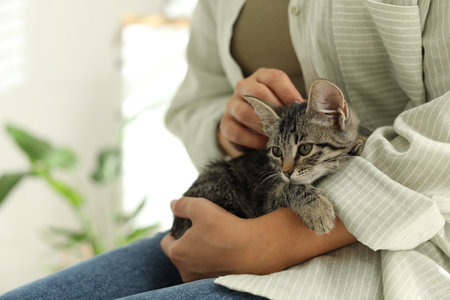1. Understanding Therapy Cats
Therapy cats play a unique role in providing comfort and emotional support to people in need. Unlike service animals or emotional support animals, therapy cats are specifically trained to offer affection and companionship in various settings such as hospitals, nursing homes, schools, and rehabilitation centers.
What Are Therapy Cats?
Therapy cats are friendly, well-behaved felines that visit different places to bring joy and relaxation to individuals facing physical or emotional challenges. Their calm demeanor and soothing presence help reduce stress, lower blood pressure, and improve overall well-being.
How Therapy Cats Differ from Other Support Animals
Many people confuse therapy cats with service animals or emotional support animals, but each serves a different purpose. Below is a comparison of their roles:
| Type of Animal | Purpose | Training Requirements | Legal Protections |
|---|---|---|---|
| Therapy Cats | Provide comfort and companionship in public settings | Basic training for calmness and friendliness | No special legal protections; access depends on facility policies |
| Service Animals | Assist individuals with disabilities by performing specific tasks | Extensive training for disability-related tasks | Protected under the Americans with Disabilities Act (ADA) |
| Emotional Support Animals (ESAs) | Provide emotional support to owners with mental health conditions | No formal training required | Certain housing protections under the Fair Housing Act (FHA) |
The Role of Therapy Cats in Healing
The presence of a therapy cat can have profound effects on mental and physical health. Studies have shown that interacting with cats can reduce anxiety, improve mood, and even promote faster recovery in patients. Their soft purring and gentle nature make them ideal companions for those dealing with stress or loneliness.
The Qualities of a Good Therapy Cat
A successful therapy cat should have a calm temperament, enjoy human interaction, and be comfortable in new environments. They must also tolerate being handled by different people without showing aggression or fear.
The Growing Popularity of Therapy Cats
The use of therapy cats is becoming more recognized across the U.S., with more organizations incorporating feline-assisted therapy into their programs. As awareness grows, so does the appreciation for these amazing animals and their ability to bring comfort to those in need.
2. The Science Behind Feline Comfort
Therapy cats have a unique way of bringing comfort and healing to people in need. But what exactly makes them so special? Science has shown that interactions with cats can have profound psychological and physiological benefits. From reducing stress to lowering blood pressure, these furry companions offer more than just cuddles—they provide real health benefits.
Stress Reduction Through Purring
A cat’s purr is more than just a soothing sound—it has actual therapeutic effects. Studies suggest that the frequency of a cat’s purr (between 25 and 150 Hz) can promote healing in bones and tissues. Additionally, the rhythmic sound helps lower cortisol levels, which are responsible for stress.
Lowered Blood Pressure & Heart Health
Spending time with therapy cats has been linked to improved cardiovascular health. Petting a cat encourages relaxation, which can lead to lower blood pressure and a reduced risk of heart disease. A study even found that cat owners are less likely to suffer from heart attacks compared to non-cat owners.
Emotional Support & Mental Well-Being
Cats offer unconditional companionship, which is particularly beneficial for individuals struggling with anxiety, depression, or loneliness. Their presence provides emotional stability, making them excellent companions for those in hospitals, nursing homes, or therapy settings.
Key Benefits of Therapy Cats
| Benefit | Description |
|---|---|
| Stress Reduction | Their purring sound lowers cortisol levels and promotes relaxation. |
| Lower Blood Pressure | Petting a cat can induce calmness, reducing hypertension risks. |
| Mental Well-Being | Cats provide emotional support for those experiencing anxiety or depression. |
| Pain Relief | The vibrations from purring may aid in physical healing and pain management. |
The Unique Bond Between Humans and Cats
The bond between humans and cats goes beyond simple companionship. Their intuitive nature allows them to sense when their owners need comfort, making them ideal therapy animals. Whether they curl up beside you during a tough day or simply offer a calming presence, therapy cats have an incredible ability to heal both the mind and body.
![]()
3. What Makes a Cat a Good Therapy Animal?
Not all cats are suited to be therapy animals. While many felines bring comfort to their owners, therapy cats require specific traits that allow them to interact with different people in various environments. A successful therapy cat needs the right temperament, behavior, and training to provide emotional support effectively.
Key Traits of a Successful Therapy Cat
Therapy cats must have a calm and friendly nature, but there are several other qualities that make them well-suited for this role.
Temperament
- Calm and Gentle: A good therapy cat remains relaxed even in new or noisy environments.
- Affectionate: They should enjoy being petted and interacting with different people.
- Adaptable: Therapy cats must be comfortable around strangers and new situations.
Behavior
- No Aggression: They should not react aggressively when handled.
- No Excessive Meowing: A quiet demeanor is essential to avoid causing distress.
- Litter Box Trained: Cleanliness is crucial when visiting facilities like hospitals or nursing homes.
Training Requirements
A well-trained therapy cat ensures safe and positive interactions with people in need. Training focuses on socialization, obedience, and exposure to different settings.
| Training Aspect | Description |
|---|---|
| Socialization | Cats should be exposed to various people, sounds, and environments from a young age. |
| Leash Training | A therapy cat should be comfortable wearing a harness and leash for safe visits. |
| Tolerance to Handling | Cats must allow gentle handling by strangers without stress or aggression. |
| Basic Commands | They should respond to simple cues like coming when called or staying still during visits. |
The Importance of Choosing the Right Cat
Selecting the right cat for therapy work is crucial. Even if a cat has a loving personality at home, it may not enjoy being around strangers or traveling frequently. Cats with naturally calm and affectionate dispositions tend to excel as therapy animals. Proper training and early socialization further enhance their ability to provide comfort and companionship to those in need.
4. How Therapy Cats Help in Different Settings
Therapy cats provide comfort and emotional support in various environments, helping people cope with stress, anxiety, and loneliness. Their calming presence has been shown to improve mood, reduce blood pressure, and even encourage social interaction. Lets explore some of the key places where therapy cats make a significant impact.
Hospitals
Hospitals can be stressful places for patients, families, and even healthcare workers. Therapy cats bring warmth and companionship, helping to ease anxiety and promote relaxation. Studies have shown that interacting with animals can lower cortisol levels and increase serotonin production, which enhances overall well-being.
Nursing Homes
For elderly residents in nursing homes, therapy cats provide much-needed affection and companionship. Many seniors experience loneliness or cognitive decline, and the presence of a therapy cat can stimulate memory recall and emotional connection. Petting a cat also encourages gentle physical activity, which is beneficial for older adults.
Schools
In educational settings, therapy cats help students manage stress and improve focus. Schools use therapy animals to assist children with special needs, such as autism or ADHD, by creating a soothing environment that enhances learning. Therapy cats can also be part of reading programs where kids read aloud to them to build confidence.
Rehabilitation Centers
People recovering from physical injuries or mental health challenges benefit greatly from therapy cats in rehabilitation centers. These feline companions provide motivation for movement, emotional encouragement, and a sense of responsibility in patients undergoing therapy.
Comparing Therapy Cat Benefits Across Different Settings
| Setting | Main Benefit |
|---|---|
| Hospitals | Reduces stress and promotes relaxation |
| Nursing Homes | Provides companionship and stimulates memory |
| Schools | Aids in emotional regulation and learning |
| Rehabilitation Centers | Motivates recovery through emotional support |
No matter where they are placed, therapy cats have an incredible ability to bring comfort and joy to those in need. Their quiet presence and affectionate nature make them ideal companions for improving mental and physical well-being.
5. How to Get Involved with Therapy Cats
If you’re a cat owner and have noticed that your feline friend has a calm and affectionate nature, you might consider training them to become a therapy cat. Therapy cats bring comfort and joy to people in hospitals, nursing homes, schools, and other settings. Here’s how you can get started on this rewarding journey.
Understanding the Requirements for Therapy Cats
Not every cat is suited for therapy work. Cats that thrive in this role tend to share common traits, such as:
- A calm and friendly temperament
- Comfortable being handled by strangers
- No history of aggression or excessive fearfulness
- Good health and up-to-date vaccinations
- An ability to adapt to new environments
The Certification Process for Therapy Cats
Becoming a certified therapy cat requires going through an evaluation process. Different organizations offer certification programs, each with their own specific requirements. Below is an overview of the general steps involved:
| Step | Description |
|---|---|
| 1. Assess Your Cat’s Personality | Make sure your cat is comfortable with different environments and enjoys interacting with people. |
| 2. Train Basic Commands | Your cat should be able to stay calm in unfamiliar situations and respond well to handling. |
| 3. Visit a Veterinarian | A clean bill of health is required before applying for certification. |
| 4. Choose a Certification Organization | Look into reputable groups such as Pet Partners or Love on a Leash. |
| 5. Complete the Evaluation Process | Your cat will be tested on behavior, friendliness, and adaptability. |
| 6. Start Volunteering | Once certified, begin visiting hospitals, schools, or care facilities where therapy animals are welcome. |
Finding Volunteer Opportunities
Once your cat is certified, you can start looking for places where therapy cats are needed. Some common locations include:
- Nursing homes – Providing companionship for elderly residents
- Hospitals – Offering comfort to patients undergoing treatment
- Shelters – Helping children or adults cope with stress and trauma
- Libraries – Participating in reading programs for kids who benefit from reading to animals
- Counseling centers – Assisting individuals dealing with emotional challenges
Tips for a Successful Therapy Cat Experience
If you’re ready to start working with your therapy cat, keep these tips in mind:
- Pace your visits so your cat doesn’t get overwhelmed.
- Always carry essentials like treats, water, and cleaning supplies.
- Create positive experiences by rewarding your cat after each session.
- Respect your cat’s limits—if they show signs of stress, take breaks as needed.
- Communicate with staff at the facility to understand their guidelines and expectations.
The Rewarding Journey of Therapy Cat Volunteering
Training your cat for therapy work can be incredibly fulfilling—not just for those receiving comfort but also for you as a pet owner. Seeing the joy your feline brings to others makes the effort worthwhile. If you believe your cat has what it takes, consider taking the first step today!


